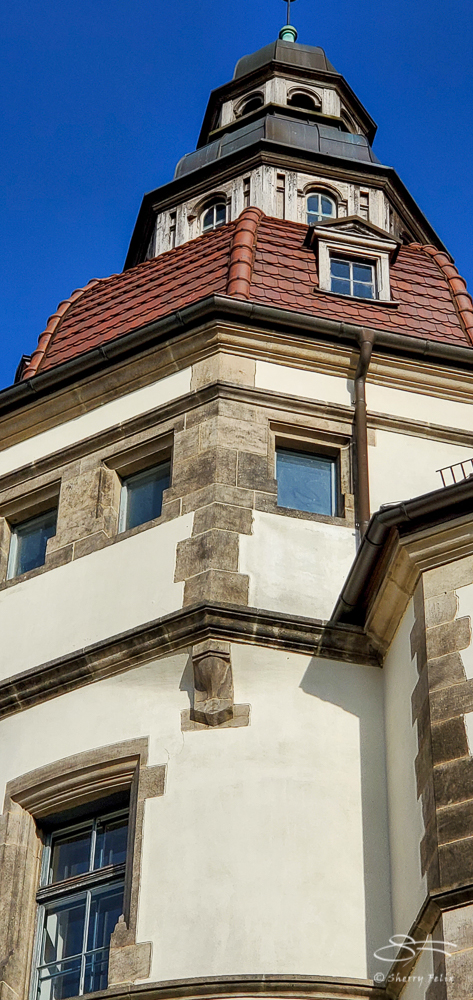We went with the family to Cottbus. We saw an art museum there with lovely art about miners. No photographs allowed. The town has an intersting history.
The following is from Wikipedia (Cottbus – Wikipedia). “Cottbus is a university city and the second-largest city in Brandenburg, Germany. Situated around 125 km (78 mi) southeast of Berlin, on the River Spree, Cottbus is also a major railway junction with extensive sidings/depots. Although only a small Sorbian minority lives in Cottbus itself, the city is considered as the political and cultural center of the Sorbs in Lower Lusatia.
The settlement was established in the 10th century, when Sorbs erected a castle on a sandy island in the River Spree. The first recorded mention of the town’s name was in 1156. In the 13th century German settlers came to the town and thereafter lived side by side with the Sorbs. In the Middle Ages Cottbus was known for wool, and the town’s drapery was exported throughout Brandenburg, Bohemia (Czechia) and Saxony. In 1445 Cottbus was acquired by the Margraviate of Brandenburg from Bohemia. In 1514 Jan Rak founded the Universitas Serborum, a Sorbian gymnasium, in the city. In 1701 the city became part of the Kingdom of Prussia. It was also ruled by Saxony between 1807 and 1813. In 1815 the surrounding district of Lower Lusatia was ceded by the Kingdom of Saxony to Prussia, and in 1871 it became part of the German Empire. According to the Prussian census of 1905, the city of Cottbus had a population of 46,270, of which 97% were Germans, 2% were Sorbs and 1% were Poles.
In interwar Germany, the town was the site of a concentration camp for unwanted Jewish immigrants from Eastern Europe. During World War II, a Nazi prison for women was operated in the city with multiple forced labour subcamps located both in the city and other places in the region. In the final weeks of the war, Cottbus was taken by the Red Army on 22 April 1945. From 1949 until German reunification in 1990, Cottbus was part of the German Democratic Republic (East Germany).”
Information about the Spremberger Turm – Wikipedia.
The plaque (“Honor and glory to the fighters Kapp and Luttwitz 15 March 1920.” Cottbus 10/19/2021) refers to the “Kapp Putsch, also known as the Kapp–Lüttwitz Putsch, named after its leaders Wolfgang Kapp and Walther von Lüttwitz, was an attempted coup against the German national government in Berlin on 13 March 1920. Its goal was to undo the German Revolution of 1918–1919, overthrow the Weimar Republic, and establish an autocratic government in its place. It was supported by parts of the Reichswehr, as well as nationalist and monarchist factions.” Kapp Putsch – Wikipedia

Cottbus 10/19/2021 
Cottbus 10/19/2021 
Cottbus 10/19/2021 
Amedeo and Heike in Cottbus 10/19/2021 
Spree, Cottbus 10/19/2021 
Cottbus 10/19/2021 
Cottbus 10/19/2021 
Cottbus 10/19/2021 
Cottbus 10/19/2021 
Cottbus 10/19/2021 
Klosterkirche, Cottbus 10/19/2021 
Cottbus 10/19/2021 
Cottbus 10/19/2021 
We had coffee and cake here. Cottbus 10/19/2021 
We bought cake here. Cottbus 10/19/2021 
Cottbus 10/19/2021 
Cottbus 10/19/2021 
Spremberger Turm, Cottbus 10/19/2021 
Cottbus 10/19/2021 
“Honor and glory to the fighters Kapp and Luttwitz 15 March 1920.” Cottbus 10/19/2021 
Cottbus 10/19/2021 
Cottbus 10/19/2021 
Felix family in Cottbus 10/19/2021 
Felix family in Cottbus 10/19/2021 
Cottbus 10/19/2021 
Cottbus 10/19/2021
Such a wonderful photography, stunning beauty 👌🌷🙏😊
LikeLike
Thanks you so much.
LikeLiked by 1 person
You certainly got around when you were in Germany
LikeLike
Only south of Berlin.
LikeLiked by 1 person
Well, yes, but you saw a good few places!
LikeLiked by 1 person
The more I look at this, the more I realize what I’ve never seen yet;-)
Nice series of photos and thanks for sharing.
LikeLike
Every time I revisit somewhere I see new things. 🙂
LikeLike